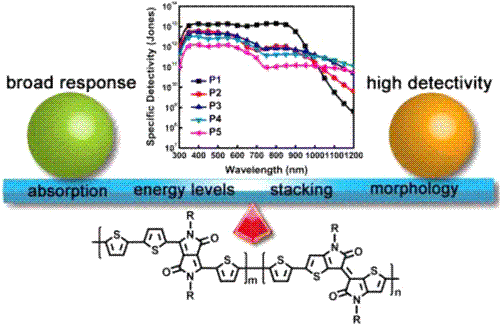[2015][Macromolecules, 2015, 48 (12), 3941–3948]Optimization of Broad-Response and High-Detectivity Polymer Photodetectors by Bandgap Engineering of Weak Donor–Strong Acceptor Polymers
writer:Ji Qi, Jinfeng Han, Xiaokang Zhou, Dezhi Yang, Jidong Zhang, Wenqiang Qiao*, Dongge Ma, Z. Y. Wang*
keywords:Photodetector
source:期刊
specific source:Macromolecules, 2015, 48 (12), 3941–3948
Issue time:2015年
A series of weak donor–strong acceptor polymers containing two different electron-deficient units (diketopyrrolopyrrole and thienoisoindigo) are synthesized and used in broad-response and high-detectivity polymer photodetectors. By adjusting the composition ratio of the two acceptors, the absorption spectra, energy levels, molecular stacking, and film morphology are affected, which in turn influence the photodetector performance. With increased thienoisoindigo component, the HOMO energy levels shift from ?5.41 to ?4.76 eV, and the LUMO energy levels are nearly unchanged, corresponding to reduced bandgaps and red-shifted absorption spectra. 1,8-Diiodooctane additive shows greatly impact on the film morphology, which affects the photodetector performance significantly. Going from P1 to P5, the detectivity decreases, but the response range increases. The photodetector based on P4 exhibits detectivity of greater than 1011 Jones in a broad spectral region of 300–1200 nm, which is really promising for UV–vis–NIR light detection.
